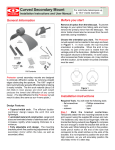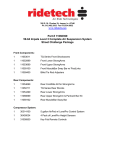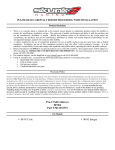Download FCM PDF - Fat Cat Motorsports
Transcript
FCM coil-over assembly instructions, Bilstein shock, with MCU bushing for 2.5” ID springs General comments about maintenance/repair work: It has been our experience (beautifully described by Robert Pirsig, who wrote ‘Zen and the Art of Motorcycle Maintenance’) that when working on any machine or mechanical device, it is best to begin when rested, with sufficient time, light, and energy to complete the job. When in doubt, get help and ask questions. When working on suspensions this is particularly important as it is literally your connection to the road. If you find yourself stressed, tired, hungry, or frustrated please do yourself and us a favor by taking a break or giving us a call to ask a question. Your Miata provides you and your passengers with enjoyment and safety – both deserve the best you can give it during this important work. Two brief, pointed thoughts to ponder (we didn’t coin them, they just fit): ‘Don’t make an important decision on an empty stomach.’ ‘Never answer a letter when you’re angry.’ Tools/references: Impact tools are highly recommended in general and esp. for shock mount assembly although Vise Grips may be substituted. 100 lb-ft torque wrench Standard metric socket/ratchet sets Low-profile floor jack (required in some cases) (4) Jack stands Gorilla Glue or similar adhesive (available from the local hardware store) Anti-seize compound Tape measure Mazda Factory Service Manual for your model year Heavy-duty work gloves and latex/nitrile gloves Safety goggles Supplied tools/parts: Loctite 242 Respirator wipe (to clean the shock rod threads prior to adding Loctite and the mold release compound from the urethane spring isolators) Allen key (for securing clamp-style adjustable spring perch) ©2014 Fat Cat Motorsports, Inc. Page 1 of 12 Shaikh J. Ahmad Coilover and shock mount kit contents 9 8 5 2 Item 1 2 3 4 5 6 7 8 9 10 11 12 13 1 Qty 4 4 4 4 4 4 4 1 4 4 4 4 1 3 4 7 6 P/N Description FCM-WSHR-SST-M14 M14 ID x 37mm OD washer FCM-NUT-SHLDR-M10 M10 shoulder nut for Bilstein shocks FCM-BUSH-NA-UPR Upper MCU shock mount bushing FCM-BUSH-NA-LWR Lower MCU shock mount bushing FCM-WSHR-AL-M10 Anodized M10 aluminum washer FCM-ISOL-40250 Urethane isolator for 2.5” race spring FCM-BSTOP-36MM-LG 36mm MCU bump stop FCM-WIPE-3M 3M cleaning wipe FCM-SPACER-STEEL Extra spacers for Bilstein shocks FCM-SLEEVE-2.5” Threaded coilover sleeve FCM-CLAMP-PERCH Clamp-style spring perch for 2.5” springs SCR-HEX-1/4-20-7/8 Hex head screw, ¼-20x 7/8” long ALLEN KEY, 5/16” 5/16” Allen key for securing hex screw 10 11 12 ©2014 Fat Cat Motorsports, Inc. Page 2 of 12 13 Shaikh J. Ahmad Bump stop orientation 1. In general, all bump stops are placed with the smaller/narrowed end facing toward the shock body. The Bilstein spacer (either grey or stainless-steel colored) will fit easily into the flat end of the bump stop. 2. Place bump stop on shaft (36mm shown) followed by the Bilstein nut. Assembling the threaded sleeve/adjustable spring perches 3. Starting at the end of the threads, apply anti-seize compound (not supplied) along ¾ of the screw’s length. This will prevent galling, especially in areas with severe weather. 4. Do not over-tighten the locking screw. Approximately 1 turns after bolt head touches perch will be snug. Attempt to rotate sleeve. If still somewhat loose, tighten the screw a little. There will still be some gap between the cut-out. ©2014 Fat Cat Motorsports, Inc. Page 3 of 12 Shaikh J. Ahmad 5. The sleeve has two possible orientations., put the deep groorved side onto the shock body first (as shown in above right picture). This end goes onto shock body 6. Thread the clamp perch onto the sleeve and slide the assembly over the shock body, followed by the appropriate spring for front or rear. Double check the rate! Upper spring isolators, cupped washer and shock mount assembly NOTE1: Due to chemical residue from the manufacturing process, we recommend using latex or nitrile gloves when handling the polyurethane isolators. ©2014 Fat Cat Motorsports, Inc. Page 4 of 12 Shaikh J. Ahmad 7. Use Simple Green or similar solvent to remove the mold release compound from the flat surface of the upper spring isolator. 8. We recommend gluing the isolator to the shock mount - Gorilla Glue (available at most auto parts stores) is very effective. This helps re-centering of the 2.5” spring when the car is raised/lowered. 9. Clean the lower part of the shock mount with a damp cloth then leave a trace of moisture on the mount per the Gorilla Glue instructions. 10. Support the inverted shock mount with the spring perch from your coilover sleeve. The mount should be stable. Apply the adhesive in a ring around the isolator then press it into place on the shock mount. Rotate the isolator one revolution to distribute the adhesive. NOTE2: Be sure the isolator rests between the dowel pins for proper centering then weight the isolator with a 2.5” spring. This centering is important for proper positioning of the lower bushing. The spring’s weight will prevent the glue from expanding and pushing the isolator away from the mount. Allow the glue to cure for at least an hour before continuing assembly. ©2014 Fat Cat Motorsports, Inc. Page 5 of 12 Shaikh J. Ahmad Leave spring on isolator for about an hour until glue cures Installation of shock mount, bushing centering during tightening 11. Check that the isolators have cured then continue assembly. Place the lower bushing (conical side toward mount) inside the isolator, followed by the red flat washer. NOTE3: Our red washers fit a new shock perfectly but a previously-used Bilstein can flare the ‘shelf’ (below the threads) slightly. Mild filing/reaming of our washer may be needed. Note conical section goes toward mount NOTE4: The following step is VERY IMPORTANT to ensure the shoulder nuts remain secured during driving. Users who have omitted the Loctite have noted the nut backing off over time, resulting in rattling/clunking. The threadlocker will cure in about 20 minutes - do not apply until you are ready to torque the mounts. 12. Apply Loctite 242 to the middle 3 threads. Place the partially-assembled shock mount on the shaft. ©2014 Fat Cat Motorsports, Inc. Page 6 of 12 Shaikh J. Ahmad With use, this shelf may flare slightly. Red washer must sit directly above Bilstein spacer! NOTE5: The upper bushing is symmetric, there is no preferred orientation in the shock mount. 13. Add the upper bushing, M14 fender washer and M10 custom nut. Upper bushing has symmetric edges ©2014 Fat Cat Motorsports, Inc. Page 7 of 12 Shaikh J. Ahmad NOTE6: The MCU bushings need to be guided into place during tightening. The lower bushing is aided via the lower isolator and red flat washer but the upper bushing may need to be reset by hand during final tightening. 14. Tighten the shock assembly / custom shoulder nut / M14 fender washer With impact wrench: Lower the adjustable spring perch as far as necessary to get access to the shock shaft. We have found it easy to hold the shaft in a gloved hand and use an impact wrench/19mm socket to secure the custom nut. No impact wrench: You will need two Vise Grips (set gap to about ¼”), placed 180 degrees apart, to clamp between M14 washer and lip on shock mount. This compresses the bushings so the nut can be spun down and tightened (photo below). Without an impact wrench, there will be more resistance as the nut turns so you will have to use stronger means to keep the shaft from spinning. A strap wrench works well, as does a mouse pad or other thick, high-friction material held inside pliers, etc. Whatever your approach, be sure the shaft does not spin as this may damage internal seals. Once the upper bushings are centered and tightened, torque the upper nut to approximately 20-25 lb-ft. The goal in tightening is for the shoulder nut to make contact with the red washer, properly loading the MCU bushings to their operating state. The Loctite ensures the nut remains torqued. ©2014 Fat Cat Motorsports, Inc. Page 8 of 12 Shaikh J. Ahmad Checking for proper installation/torque ~¼” (6.3mm) gap for proper assembly 15. Ensure the gap is about 1/4” and the bushings are still centered in the shock mount. NOTE7: The ~¼” ( ~6.3mm) gap indicates proper torque. These steps along with using Loctite 242 or similar threadlocker in step 12 are VERY important to proper functioning of the shock mount assembly. Loosen the nut, re-center the bushing(s), and re-tighten as needed. 16. Remember to place the gasket (from your original shock mounts) on the dowel pins of the newlyassembled coilover. ©2014 Fat Cat Motorsports, Inc. Page 9 of 12 Shaikh J. Ahmad Fully assembled front and rear FCM Bilstein coil-overs Set starting ride height 17. Position the lower spring perch approximately 2” from the bottom of the sleeve, similar to the above photo. Remove existing spring/shock and installed fully assembled FCM coilovers 18. Install the coil-over (we use the ‘San Diego’ method – see Appendix for summary). Handtighten the upper control arm bolt, the upper shock nuts, and the lower shock bolt. Final tightening comes after ride height is set. ©2014 Fat Cat Motorsports, Inc. Page 10 of 12 Shaikh J. Ahmad Check and adjust ride height NOTE8: One turn on the coil-over sleeve produces about 1/8” change in ride height. 19. We recommend these ride height targets: Stock springs Springs up to 300/220 Spring up to 450/325 13.0 front / 13.25 rear (may vary from year to year). 12.75 front / 13.0 rear (about 1/4"-1/2” lowering) 12.5 front / 12.75 rear (about 1/2”-3/4” lowering) 20. Place the jacking pad in the center of the lower control arm and jack up until the corner begins to come off the jack stand. The jack has a tendency to slip on the curved surface so keep note of this. 21. Measure the distance from hub center to fender lip. This will be close to the ride height you would see if the car was lowered onto the ground. NOTE9: In our experience with this method, once on the ground your car will sit about 0.5” (12mm) lower than the position you measure on the jack stand. Keep this in mind when adjusting the spring perches. 22. If adjustments need to be made, lower the jack to put the suspension into droop, loosen the clamp perch set screw (or jam nut if used) and raise/lower the spring perch. NOTE10: Rotating the spring perch DOWN lowers the vehicle’s height, and vice versa. 23. Repeat 20 through 22 for each corner until within ¼” of desired height. 24. While the corner is jacked up as in step 20, torque-tighten all loosened suspension bolts. Tighten suspension bolts (those with bushings must be tightened at nominal ride height) Upper shock nuts Lower shock bolt 25 lb-ft 62 lb-ft Sway bar end link bolts 37 lb-ft Wheel lug nut 85 lb-ft Front upper control arm bolt 100 lb-ft NOTE11: I use these values on my vehicles, some are at the upper end of the factory range Attach and tighten sway bar bolts to control arm (while front or rear is jacked up) 25. Jack both front control arms up at the same time to secure the sway bar bolts. If using stock endlinks, torque them now. Otherwise, for adjustable end links (highly recommended), perform tightening will need to be done with full vehicle weight on the suspension. Use of a lift or ramps is required for ground clearance. 26. Hand-tighten the wheels, lower the vehicle and perform final torque-tightening of the sway bar ©2014 Fat Cat Motorsports, Inc. Page 11 of 12 Shaikh J. Ahmad Short test drive, re-check/adjust ride height 27. Take a short drive to settle the suspension. Verify ride height is still within desired range or adjust. 28. Put about 30-50 miles on the car before getting an alignment. The goal is to settle any suspension bushings loosened during the installations and ensure the ride height does not change after alignment. If you will have a corner-balance done at the same time, we recommend a short drive after installation before corner-balancing and alignment. You should have alignment recommendations from us already as part of the consultation but if not, call or email for our specific recommendation for your situation APPENDIX – Shock removal/installation method (taken from Miata.net Garage section - http://www.miata.net/garage/shocks.html) 1. Jack up front of car and place on jack stands at the side rail jacking points. 2. Remove front wheels. 3. Inside the engine bay, loosen center nut holding upper spring mount to shock shaft (14mm socket w/extension). Only back this off a few turns, not all the way. This helps get the spring off easier later. 4. Remove the 2 nuts holding upper spring mount to the body (14mm socket). 5. Remove upper through bolt connecting sway bar end link to sway bar (14mm socket and box wrench). Note which way the bolt goes. 6. Remove lower shock absorber mounting bolt (17mm socket and box wrench). 7. Loosen rearmost mounting bolt for front sway bar frame bracket until the back is flush with the backing nut (12mm socket with extension). 8. Remove upper control arm mounting bolt. Use 21mm box wrench on the nut and a 21 mm socket on the bolt head. Slide the bolt back through the big washer towards the sway bar frame bracket. Rock the a-arm up and down if the bolt is stuck. Once the bolt is all the way out of the aarm, just leave it where it is. 9. Remove ABS bracket bolt (if so equipped). Being careful that the rubber brake hose is not in tension, pry down on (or stand on) the hub or lower control arm until the top of the shock/spring unit can swing out clear of the shock tower. 10. Disassemble shock/spring unit using appropriate spring compressor. Be VERY careful!! 11. Reassembly is the reverse of disassembly. NOTE12: Do not tighten mounting bolts for sway bar end links, shock lower mount or upper control arm while the car is in full droop. Once everything is back in place but not tight, place a jack under the lower arm as close to the hub as possible. Jack up until the car just starts to come off the jack stand. Now tighten those mounting bolts. You should also torque the shock shaft upper mounting nut at this time. ©2014 Fat Cat Motorsports, Inc. Page 12 of 12 Shaikh J. Ahmad


















